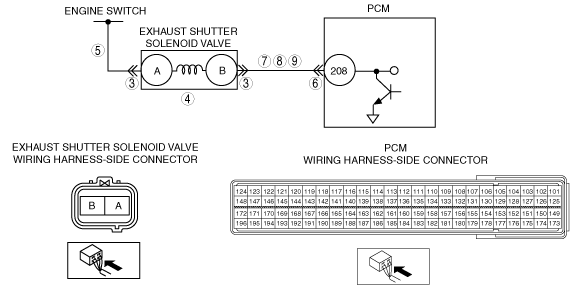|
1
|
VERIFY FREEZE FRAME DATA HAS BEEN RECORDED
• Has FREEZE FRAME DATA been recorded?
|
Yes
|
Go to the next step.
|
|
No
|
Record the FREEZE FRAME DATA on the repair order, then go to the next step.
|
|
2
|
VERIFY RELATED SERVICE INFORMATION AVAILABILITY
• Verify related Service Information availability.
• Is any related Service Information available?
|
Yes
|
Perform repair or diagnosis according to the available Service Information.
• If the vehicle is not repaired, go to the next step.
|
|
No
|
Go to the next step.
|
|
3
|
INSPECT EXHAUST SHUTTER SOLENOID VALVE CONNECTOR FOR POOR CONNECTION
• Turn the ignition switch off.
• Inspect for poor connection (such as damaged/pulled-out pins, corrosion).
• Is there malfunction?
|
Yes
|
Repair or replace the terminal, then go to Step 10.
|
|
No
|
Go to the next step.
|
|
4
|
INSPECT EXHAUST SHUTTER SOLENOID VALVE
• Perform exhaust shutter solenoid valve inspection.
• Is exhaust shutter solenoid valve normal?
|
Yes
|
Go to the next step.
|
|
No
|
Replace the exhaust shutter solenoid valve, then go to Step 10.
|
|
5
|
INSPECT EXHAUST SHUTTER SOLENOID VALVE POWER SUPPLY CIRCUIT FOR OPEN CIRCUIT OR SHORT TO GROUND
• Turn the ignition switch to the ON position (Engine off).
• Measure the voltage between exhaust shutter solenoid valve terminal A and body ground.
• Is the voltage B+?
|
Yes
|
Go to the next step.
|
|
No
|
Repair or replace the wiring harness for open circuit, then go to Step 10.
|
|
6
|
INSPECT PCM CONNECTOR FOR POOR CONNECTION
• Turn the ignition switch off.
• Disconnect the PCM connector.
• Inspect for poor connection (such as damaged/pulled-out pins, corrosion).
• Is there malfunction?
|
Yes
|
Repair or replace the terminal, then go to Step 10.
|
|
No
|
Go to the next step.
|
|
7
|
INSPECT EXHAUST SHUTTER SOLENOID VALVE CONTROL CIRCUIT FOR OPEN CIRCUIT
• Disconnect the PCM connector.
• Inspect for continuity exhaust shutter solenoid valve terminal B and PCM terminal 208.
• Is there continuity?
|
Yes
|
Go to the next step.
|
|
No
|
Repair or replace the wiring harness for open circuit, then go to Step 10.
|
|
8
|
INSPECT EXHAUST SHUTTER SOLENOID VALVE CONTROL CIRCUIT FOR SHORT TO GROUND
• Inspect for continuity exhaust shutter solenoid valve terminal B and body ground.
• Is there continuity?
|
Yes
|
Repair or replace the terminal, then go to Step 10.
|
|
No
|
Go to the next step.
|
|
9
|
INSPECT EXHAUST SHUTTER SOLENOID VALVE CONTROL CIRCUIT FOR SHORT TO POWER
• Disconnect the exhaust shutter solenoid valve connector.
• Turn the ignition switch to the ON position (Engine off).
• Measure the voltage between exhaust shutter solenoid valve terminal A and body ground.
• Is the voltage B+?
|
Yes
|
Repair or replace the wiring harness for short to power supply, then go to the next step.
|
|
No
|
Go to the next step.
|
|
10
|
VERIFY TROUBLESHOOTING OF DTC P1528 COMPLETED
• Make sure to reconnect all disconnected connectors.
• Clear the DTC from the PCM memory using the M-MDS.
• Start the engine.
• Is the PENDING CODE for this DTC present?
|
Yes
|
Replace the PCM, then go to the next step.
|
|
No
|
Go to the next step.
|
|
11
|
VERIFY AFTER REPAIR PROCEDURE
• Perform the “AFTER REPAIR PROCEDURE”.
• Are any DTCs present?
|
Yes
|
Go to the applicable DTC troubleshooting.
|
|
No
|
Troubleshooting completed.
|
